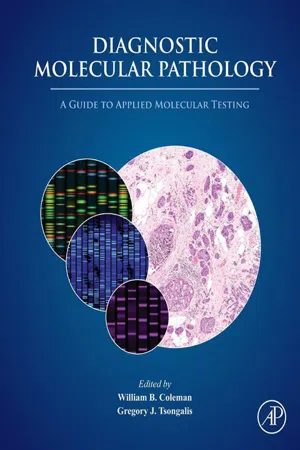
Diagnostic Molecular Pathology
A Guide to Applied Molecular Testing
- 582 pages
- English
- ePUB (mobile friendly)
- Available on iOS & Android
Diagnostic Molecular Pathology
A Guide to Applied Molecular Testing
About this book
Diagnostic Molecular Pathology: A Guide to Applied Molecular Testing is organized around disease types (genetic disease, infectious disease, neoplastic disease, among others). In each section, the authors provide background on disease mechanisms and describe how laboratory testing is built on knowledge of these mechanisms. Sections are dedicated to general methodologies employed in testing (to convey the concepts reflected in the methods), and specific description of how these methods can be applied and are applied to specific diseases are described.The book does not present molecular methods in isolation, but considers how other evidence (symptoms, radiology or other imaging, or other clinical tests) is used to guide the selection of molecular tests or how these other data are used in conjunction with molecular tests to make diagnoses (or otherwise contribute to clinical workup). In addition, final chapters look to the future (new technologies, new approaches) of applied molecular pathology and how discovery-based research will yield new and useful biomarkers and tests.Diagnostic Molecular Pathology: A Guide to Applied Molecular Testing contains exercises to test readers on their understanding of how molecular diagnostic tests are utilized and the value of the information that can be obtained in the context of the patient workup. Readers are directed to an ancillary website that contains supplementary materials in the form of exercises where decision trees can be employed to simulate actual clinical decisions.- Focuses on the menu of molecular diagnostic tests available in modern molecular pathology or clinical laboratories that can be applied to disease detection, diagnosis, and classification in the clinical workup of a patient- Explains how molecular tests are utilized to guide the treatment of patients in personalized medicine (guided therapies) and for prognostication of disease- Features an ancillary website with self-testing exercises where decision trees can be employed to simulate actual clinical decisions- Highlights new technologies and approaches of applied molecular pathology and how discovery-based research will yield new and useful biomarkers and tests
Frequently asked questions
- Essential is ideal for learners and professionals who enjoy exploring a wide range of subjects. Access the Essential Library with 800,000+ trusted titles and best-sellers across business, personal growth, and the humanities. Includes unlimited reading time and Standard Read Aloud voice.
- Complete: Perfect for advanced learners and researchers needing full, unrestricted access. Unlock 1.4M+ books across hundreds of subjects, including academic and specialized titles. The Complete Plan also includes advanced features like Premium Read Aloud and Research Assistant.
Please note we cannot support devices running on iOS 13 and Android 7 or earlier. Learn more about using the app.
Information
Molecular Testing for Human Imunodeficiency Virus
Abstract
Keywords
Introduction
Background on HIV Infection and AIDS
Overall Epidemiology
Life Cycle of HIV
Transmission of HIV
Natural History of HIV Infection
HIV Evolution During Treatment
Molecular Tools in the Diagnosis and Follow-Up of HIV Infection
Table of contents
- Cover image
- Title page
- Table of Contents
- Copyright
- Endorsements
- Dedication
- List of Contributors
- Preface
- Section I: Introduction to Molecular Testing
- Section II: Molecular Testing in Infectious Disease
- Section III: Molecular Testing in Genetic Disease
- Section IV: Molecular Testing in Oncology
- Section V: Molecular Testing in Hematopathology
- Section VI: Molecular Testing in Personalized Medicine
- Section VII: The Future of Molecular Testing
- Index